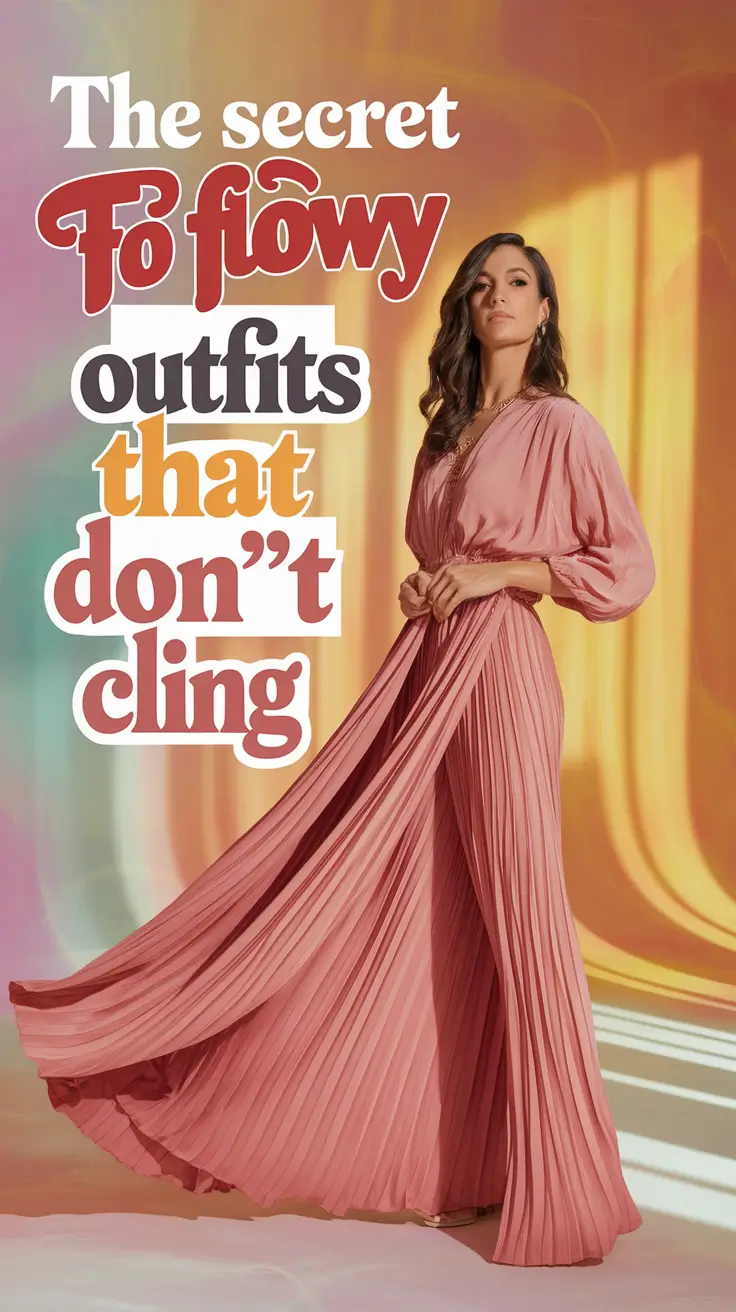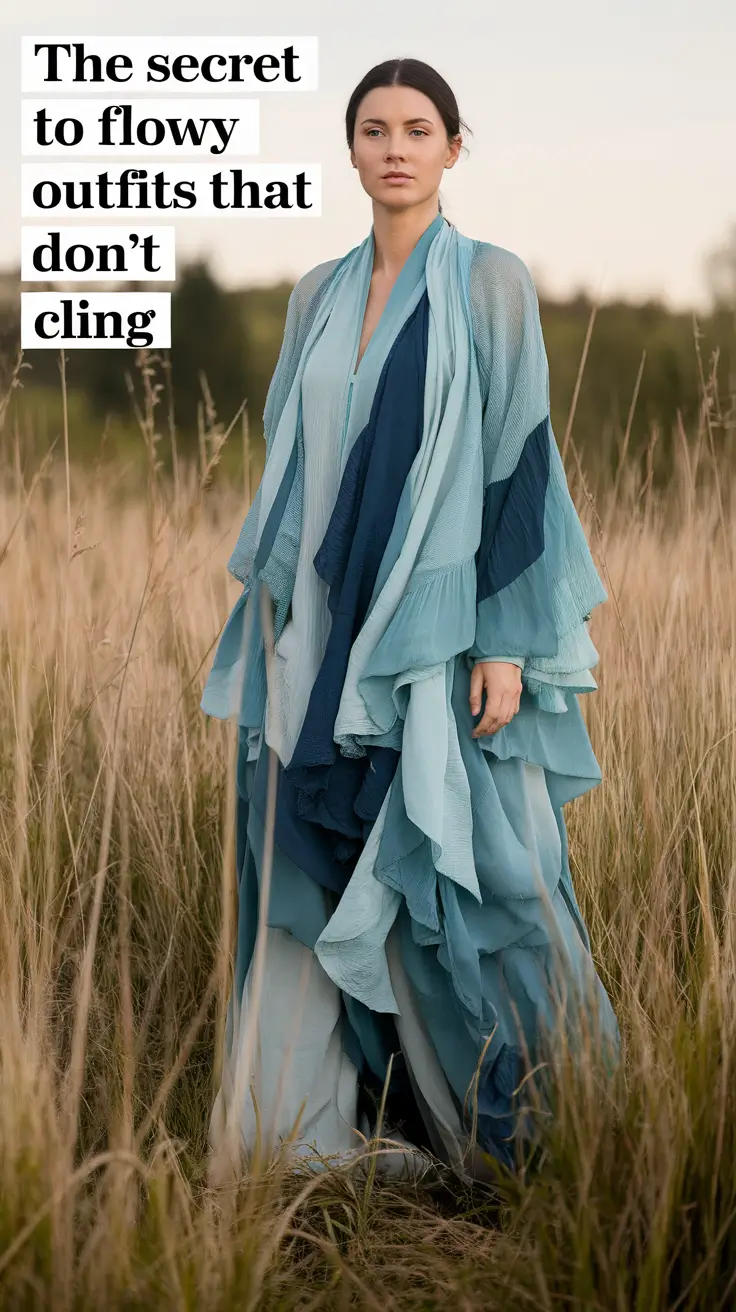Have you ever put on a light dreamy outfit, only for it to feel like it’s hugging you in all the wrong places five minutes later? That was me one warm spring afternoon while I was standing at a crosswalk with my skirt huggng my thighs like it was trying to give me a passionate embrace. In my mirror, it looked effortless. In real life? Not so much.
Outfits that are flowy promise ease and movement. However, if the fabric clings, twists, or tangles, it can destroy everything. Some dresses are fitted at the bottom while other pairs seem to have a magnetic pull towards your legs. If you wondered why this happens, you are not alone.
In this post, I’ll share everything I learned after one too many clingy moments. From the fabrics to layering tricks, let’s explore how to make outfit flowy in reality and not just in dreams. This is not about spending more; rather, it’s about making smarter selections. A few tiny tweaks made everything better for me.

Why Flowy Often Doesn’t Feel Easy
The part that caught me off guard: “flowy” does not mean worry-free.
Like many people, I thought flowing and loose fabrics would move freely as I moved. That assumption is incorrect because some garments have the tendency to look floaty. They may cling due to humidity, stick to tights, or bunch up in all the wrong places.
The Real Culprits
- Static cling Synthetic fabrics suffer the worst from this issue.
- Fabric weight Too light of a balance will cause a garment to cling instead of drape appropriately.
- No lining Even the most beautifully designed skirts can misbehave without proper lining.
This is when I became more aware of the style and the elements that impacted the design, especially how the fabric moves while walking.
The Fabrics That Actually Work (and Those That Don’t)
Fabric type became easily identifiable through my self conducted research along with the patterns I discovered. Allow me to demonstrate.
Dreamy Drapery Fabrics
- Viscose: Soft, breathable, and drapey
- Rayon challis: Light weight, but does not cling
- Silk blends: Glossy, smooth, and has minimal static
- Linen-viscose mix: Enhances the fluidity of a structured textile
Fabrics That Usually Cling
- Polyester without lining: lightweight with static tendency
- Cheap chiffon: Often overly sheer
- Thin jersey knit: light and comfy, clingy in humid weather
- Nylon blends: Good stretch but doesn’t drape well
The shift occurred with the integration of form and convenience-thinking: How does the fabric feel? Does it bounce or hang limp?
3 Simple Changes That Eliminated My Clingy Outfits Problems
This is where it all shifted.
1. Incorporate a breathable lining/half slip
I bought a neutral toned silk blend slip, and it transformed the way my skirts would move. Skirts that used to get bunched would now glide effortlessly instead.
2. Use anti-static spray (or dryer sheet)
Shocking, I know. A quick spritz, or even a light rub with a dryer sheet, goes a long way. I carry one in my tote bag just for the sake of it.
3. Select layered styles or a bit thicker cuts
To some degree, skirts with built-in linings are helpful as the fabric tends to move in a more predictable fashion rather than clinging to your legs.
While these changes may seem small and unimportant, they had the biggest impact on my life. Instead of a closet full of “almost right” outfits, I had a collection of truly “wearable” clothes.
Shopping for Flowy Styles – What to Look For
The starting point was something that seemed the most dreadful to me: a tactile experience with each and every piece of clothing present on the rack. This, surprisingly, worked.
Here’s What Added to the Results:
- Is the fabric soft and smooth?
- Is it slightly heavy—but not too much?
- Can I picture it moving around—and adhering to my skin?
- Does it come with a lining or a slip of some sort?
- Is the cut skirted to skim or does it risk a bunching balloon effect?
My moving criteria in the not so remote future:
- Stand or sit down
- Crossover and undone legs
- Walk past a mirror
- Twist at waist level
Everything gets my check elsewhere—and all elastic get a tick as outcome test.

Flowy Fabric Behavior: A Quick Reference Table
| Fabric Type | Feels Like | Prone to Cling? | Best Use Cases |
|---|---|---|---|
| Viscose | Light, breathable, smooth | Low | Summer skirts, dresses |
| Polyester (unlined) | Thin, slippery, static | High | Avoid in flowy styles |
| Linen | Crisp, airy, structured | Medium | Best with viscose blend |
| Silk/Silk Blend | Soft, luxe, fluid | Low | Occasion dresses, slips |
| Rayon Challis | Drapey, matte, flexible | Low | Daywear, beach outfits |
This chart is now stored on my phone for easy reference while shopping.
My Finally Successful “Flowy Capsule”
This is when I finally understood what was off. It wasn’t too many options. It was too many redundant, thoughtless smart options.
I created a mini-capsule of 6 fluid pieces that go together and blend with my preferred movement style:
Core pieces:
- Linen viscose skirt with a cotton lining
- Silk tank dress featuring a tucked in soft slip
- Wide leg trousers vents in viscose
- Wrap dress made of two layers of rayon
- Blouse made from muslin with sleeves that ruffle and structured bodice seam
- Crepe skirt with tiers is a maxi length for freedom of movement
Now they’re perfect for brunch, running errands, or even casual evenings out. It’s like they’ve been flawlessly tailored to my movements. My clothes do not cling. They do not bunch up. All that matters is that they remain comfortable.
How To Improve The Way Your Outfits Look In Motion
Standing in front of a closet filled with potential only to be frustrated about an “unfixable” dress does have a solution. Ask yourself this Is it really my body that’s at fault? What if it’s the material?
Apply these hypotheticals now:
- Your most clingy skirt. Try wearing a half-slip underneath and see what happens
- Dress rub a dryer sheet inside before leaving
- Your favorite floaty garment. Check the tag. Is it predominantly polyesther?
Small adjustments have life changing impacts.
Conclusions
The trick to outfits that are flowy and don’t cling is not a well kept secret. It lies in the decisions made during the shopping stages, the care routines, and outfit composition.
For me, it only took understanding fabric for everything to shift. All my favorite pieces suddenly looked good and more importantly, they felt good.
In your case, what is one small change that you made that enhanced comfort?
If you’re constructing your ideal summer closet, be sure to pin this. ✨

